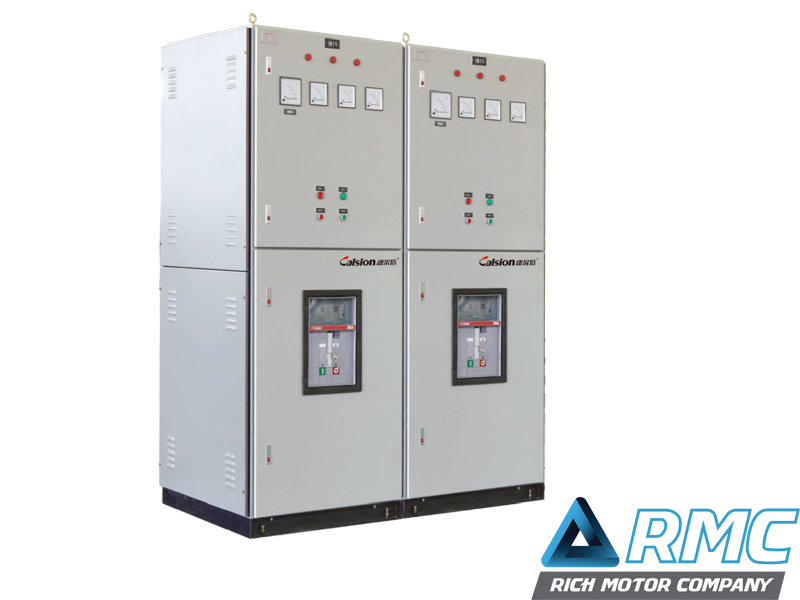SYNCHRONIZING PANELS
Synchronizing Panels Dubai UAE
Synchronizing panels are essentially composed and used to meet power framework necessities. These panels work both physically and with a programmed synchronizing capacity for at least one generator or breaker.
They are generally utilized as a part of synchronizing generators and offering multiplex arrangements.
Our brilliant scope of DG synchronizing panels is accessible with limits that achieve 10000 An and are created by our architects utilizing premium quality electrical segments including copper transport bar, protections, wires/link, PVC channels, transformers, meters, and switches.
Operating Method of Synchronising panels in UAE:
The Synchronizing board will work on a programmed mains disappointment framework. When the primary supply is hindered on one or all stages (after a customizable postpone period), the generator sets will start-up together. After an underlying warm-up period (movable), the generators will synchronize with each other through mechanized circuit breakers or contactors onto a typical bus bar. Next, the mechanized change-over switch will be shut, and the heap associated with the primary conveyance box.
The heap share units persistently screen the heap, and amid low request periods, maybe a couple of generators will be closed down to save money on fuel utilization. As the request rises again, the second and third generators will be restarted, synchronized, and reconnected to the stack. When the AMF control unit identifies that the principle supply has been reestablished, a customizable perception period is actuated before the fundamental supply is reconnected. A chill off period will then take after, after which the generator sets will be closed down. The AMF Panel incorporates a Deep Sea 5510 Controller (Synchronizing Unit):
General attributes of Synchronising panels in UAE
3-stage mains-generator voltage control
3-stage current control and 12 computerized inputs
3 Analog contributions for weight, temperature, and fuel level observing
Retentive vitality meters
RS-232 port for setup, remote control, and GSM modem (discretionary) and Setting delicate on-line encourage prompts
The decision of content dialect and Symbol detail and caution, seeing
Occasion log for alerts, status, and occasions and Working information recording
Visible estimations and Battery voltage
Stage, line, and framework mains voltage esteems and Stage, bar, and framework generator voltage esteems and Stage currently
Dynamic, receptive, and apparent power esteems and Active receptive vitality meters and Power factor per stage
Mains and generator recurrence and Motor speed (rpm) and Oil weight and Water temperature
Fuel level AND Motor running hour counter and Hours staying before next upkeep
Add up to several beginning endeavors and Level of practical beginning endeavors
Numerous Generator Applications for Prime Power
When utility power isn't accessible, at least two generators are synchronized to supply ceaseless power for burdens. They share the heaps in extent with their evaluations. Contingent upon the heap of the work environment, these generators are turned on and off for cost-effectiveness.
Various Generator Applications for Stand-by Power
Suppose utility power organization leaves its pre-chosen points of confinement. In that case, at least two generators are exchanged synchronously with each other and supply control for the genuine loads in extent with their appraisals. When civil power arrangement is reestablished to its pre-chosen restrains, the generators exchange their heaps back to the system.
Persistent Parallel Operation
Given that power service organizations charge diverse unit costs for various extended periods of the multi-day, charge a higher price when the power expended surpasses a pre-characterized sum, or farthest point the power accessible to shoppers in specific districts because of the inadequate framework, it is invaluable for the buyers to produce control in parallel with city control arrange ceaselessly. A couple of similar activity techniques are accessible. The primary method is the baseload crest cutting strategy. The wha generator framework fuels a pre-characterized segment of the dynamic load work. The rest of the component of the said stack is controlled by metropolitan power organization. This technique is favored for cogeneration frameworks where the heap is settled. Another method is the simple pinnacle cutting strategy. The power drawn from the city control framework is constrained, and a generator supplies the measure of intensity, surpassing such point of confinement. This technique is favored where the unit cost is high for utilization over a specific farthest point or power accessible in city control organize is restricted.
Different Networks
On the off chance that a working environment gets control from at least two metropolitan systems and one of them comes up short, the generators are exchanged on synchronously and start to supply management for the heap. A coupling breaker is changed to provide the capacity to the banks from a solitary busbar rather than the two transformers utilized by said systems. At the point when the system is reestablished, the generators exchange the heaps back to the designs.
Synchronizing Panels and Synchronizing Equipment
Hypothesis of Synchronizing
When shutting an electrical switch between two empowered parts of the power framework, it is vital to coordinate voltages on the electrical switch's two sides before closing. If this coordinating or "synchronizing" process isn't done effectively, a power framework unsettling influence will result, and hardware (counting generators) can be harmed. Keeping in mind the end goal to synchronize appropriately, three distinct parts of the voltage over the electrical switch must be nearly observed. The three parts of the voltage are known as the synchronizing factors and are:
- The voltage extents
- The recurrence of the voltages
- The stage point contrast between the voltages
Voltage Magnitude Synchronising Variable
On the off chance that the voltage extents are not firmly coordinated, a sudden ascent in the Mar stream will show up over the electrical switch as it is shut. For instance, if a 345 kV electrical switch were locked with a 20 kV distinction in voltage over the open electrical switch, a substantial Mvar stream would all of a sudden happen after closing. The reasonable voltage extent contrasts over the free electrical control are framework particular. Nonetheless, for general direction, a distinction of a couple of percent is probably not going to bring about any problematic issue.
Recurrence Synchronizing Variable
On the off chance that the frequencies on either side of an open electrical switch are not coordinated before shutting, a sudden change in the MW stream will show up over the electrical control as it is closed. The sudden MW stream change is because of the underlying recurrence contrast as the framework looks to build up a typical recurrence once the electrical switch is shut. The suitable recurrence contrast is again framework particular. In any case, a general rule is to include the frequencies inside 0.1 Hz of each other before shutting.
Stage Angle Synchronising Variable
The third synchronizing variable - and likely the most vital of the three - is the voltage stage point contrast. If the stage contrast between the voltages on either side of the open electrical switch isn't decreased to a little esteem, an expansive MW stream increment will suddenly happen once the electrical switch is shut. The voltage stage point contrast is the distinction between the zero intersections of the voltages on either side of the open electrical control. In a perfect world, the voltage stage point should be as near zero degrees as conceivable before shutting the electrical switch.
Synchronizing panels Examples
The significance of synchronizing can't be exaggerated. All framework administrators ought to comprehend the hypothesis and routine with regards to synchronizing. Suppose two power frameworks are synchronized using an open electrical switch, and the synchronizing procedure isn't done effectively. In that case, generators can be significantly harmed—two synchronizing situations to depict the synchronizing course.
Synchronizing panels Two Islands
The central situation accepts that two islands will be associated together utilizing the open electrical switch, as shown in Figure 1. Since they are free electrical frameworks, the two islands will have various frequencies, so each of the three synchronizing factors must be checked to guarantee they are inside acceptable limits preceding shutting the open electrical switch.
The framework administrators for the two islands will probably need to alter generator MW yield levels (or modify island stack sizes) in one of the two islands to accomplish the coveted change in frequencies and stage edges. Voltage control hardware (reactors, capacitors, and so forth.) may likewise be utilized as essential to change voltage sizes to satisfactory inside levels.
Synchronizing Panels Two Islands
Once the primary transmission line is shut interconnecting the two islands, the recurrence will be the same in the two regions. In this manner, one of the three synchronizing factors (the reproduction) is not anymore a factor. In any case, as outlined in Figure 2, the other two synchronizing factors should even now be observed. Age or potentially voltage control gear might be used to guarantee the staging point and voltage size contrasts are inside adequate limits before shutting the second electrical switch. This procedure should be simpler than shutting the principal transmission line (Scenario #1) as recurrence is never again a factor.
A synchroscope is a basic bit of hardware that is utilized to screen the three synchronizing factors. A fundamental synchroscope (represented in Figure 3) inputs voltage waveforms from the open electrical switch's two sides. If the voltage waveforms are at a similar recurrence, the synchroscope does not pivot. If the voltage waveforms are at an alternate recurrence, the synchroscope pivots in the extent to the recurrence distinction. The synchroscope needle dependably indicates the voltage stage edge contrast.
A synchroscope is a manual gadget in that an administrator must watch the "degree" to guarantee they close the electrical switch at the right time. The synchroscope is typically mounted above eye level on a "sync board." The sync board likewise contains two voltmeters with the goal that the voltage sizes can be at the same time analyzed.
The synchroscope in Figure 3 mirrors a slight voltage extent bungle and a stationary synchroscope with a staging point of around 35°. The way that the synchroscope needle isn't pivoting demonstrates recurrence is the same on either side of the electrical switch.
A synchro-check or sync check hand-off electrically decides whether the distinction in voltage extent, recurrence, and stage point fall inside permissible breaking points. As far as possible will differ with the area on the power framework. Regularly, the further far from age and load, the more stage point contrast can be endured. Sync check transfers ordinarily don't give the sign of the voltage extent, recurrence, or stage point. Async check transfer chooses inside whether its conditions for shutting are fulfilled. The sync check transfer will either permit or avert shutting, relying upon its settings. An average sync check transfer may allow locking if the breaker's voltage point is under 30°.
Use of Synchronising panels Equipment
At control plants, Synchronising panels are routinely introduced to allow manual shutting of an electrical switch. What's more, sync check transfers can be utilized to "manage" the end of the electrical control and keep occupied or unpracticed administrators from starting an awful close.
Current power plants ordinarily use programmed synchronizers. Programmed synchronizers send heartbeats to the generator exciter and senator to change the unit's voltage and recurrence. The synchronizer will consequently close the breaker when it is inside a convenient window.
Substations on the transmission framework have customarily had synchroscopes introduced. Be that as it may, a couple of substations are presently kept an eye on because of the accessibility of intense SCADA frameworks. More current substations might have a sync board due to this advancement, contingent upon the transmission organization methodology. Since most electrical switch activities are done remotely, transmission organizations frequently depend on sync check transfers to regulate breakers' shutting.
It is a conceivable synchronizing framework for substation breakers. Note the utilization of a sync scope and a sync check transfer. Electrical contacts can be opened or shut to improve the synchronizing framework as wanted.
About Us
Rich Motor Company (RMC) is the most trusted supplier and Quality manufacturing of generators powered by Kubota, john deer, and RMC G-drive engines powered by Cummins offering power and O&M services in the UAE and The Middle East.
Contact Us
Follow Us On Social Sites




